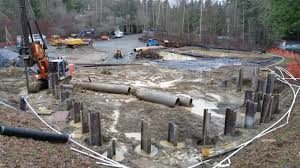What Are Pin Piles Used For
 Pin piles are also known as micro piles or mini piles and because of their small size, these piles are perfect for building foundations on sites that carry certain physical and geotechnical restraints. The design and installation necessities for pin piles will rely on the individual project, size, and kind of the design of pin pile and soil conditions. Nevertheless, these are a low-cost solution for foundation repairs.
Pin piles are also known as micro piles or mini piles and because of their small size, these piles are perfect for building foundations on sites that carry certain physical and geotechnical restraints. The design and installation necessities for pin piles will rely on the individual project, size, and kind of the design of pin pile and soil conditions. Nevertheless, these are a low-cost solution for foundation repairs.
Pin piles
The narrowly driven piles are made of a steel pipe casing, steel rebar and cement grout for added strength. The pin piles can vary from 2- 6 inches in diameter and some may have a diameter of 8 inches or more. Depending on the project, they can range from 5 feet to 60 feet in length. The main advantage of Pin piles is that they are inexpensive and easy to install for deep foundations as compared to the drilled shafts and the thicker driven piles. They can be driven through wet and soft soils to reach the deep layers of hard rocks. Moreover, as smaller machines are required to install pin piles, the limited access to some construction sites does not become a problem.
Uses of Pin piles
Pin piles are used as a technique of soil stabilization and foundation footings. They are used for lighter load piling construction projects and are selected based on how deep the soil is between the soil and bedrock. They strengthen the foundations to prevent settling, especially in poor soil conditions to prevent settling. When a building outlives its initial foundation, the pin piles are used to restore support. Soil movements caused by earthquakes or landslides can damage the support structures. The Pin Piles are ideal for construction of foundations on sites with sensitive surroundings and poor ground conditions. One can use them in areas with difficult access and restricted vertical clearance. They help raise the capacity of existing foundations and arresting ground movements. They can boost the bearing capacity of footings or mats and support foundations to allow an excavation. Pin piles can provide lateral earth retention and vertical underpinning as well as provide support for distressed structures due to burst pipes, mine subsidence, erosion, landslides, etc.
Know the soil type
It is essential to know your soils as the bearing strength can vary. Make sure to comply with building codes that define the soil types and the load-bearing values of foundation materials. If a property is already constructed with a conventional foundation system, get in touch with the local building code executive to get more information regarding soil types. The load bearing pressure may already be on the record.
When working with pin piles are on smaller projects with lighter loads and given their small diameter, the pin piles may deform under heavier loads, and this can lower their strength. Moreover, the hydraulic impact hammers used to drive the pin piles can cause noise and vibrations. When selecting Pin Piles, keep the major factors in minds such as drilling, grouting, and design fundamentals.
If you need someone to do tile roof repair in Boca Raton, you can contact preventivesupport.com




